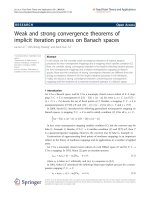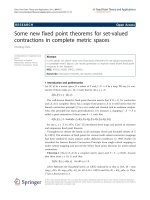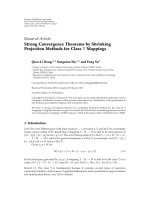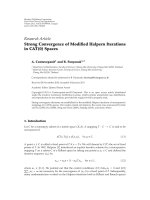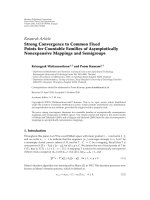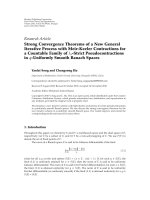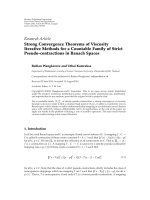Báo cáo hóa học: " WEAK AND STRONG CONVERGENCE THEOREMS FOR RELATIVELY NONEXPANSIVE MAPPINGS IN BANACH SPACES" ppt
Bạn đang xem bản rút gọn của tài liệu. Xem và tải ngay bản đầy đủ của tài liệu tại đây (539.16 KB, 11 trang )
WEAK AND STRONG CONVERGENCE THEOREMS
FOR RELATIVELY NONEXPANSIVE MAPPINGS
IN BANACH SPACES
SHIN-YA MATSUSHITA AND WATARU TAKAHASHI
Received 29 October 2003
We first introduce an iterative sequence for finding fixed points of relatively nonexpansive
mappings in Banach spaces, and then prove weak and strong convergence theorems by
using the notion of generalized projection. We apply these results to the convex feasibility
problem and a proximal-type algorithm for monotone operators in Banach spaces.
1. Introduction
Let E bearealBanachspaceandletA be a maximal monotone operator from E to E
∗
,
where E
∗
is the dual space of E. It is well known that many problems in nonlinear analysis
and optimization can be formulated as follows: find
u ∈ E such that 0 ∈ Au. (1.1)
A well-known method for solving (1.1)inaHilbertspaceH is the proximal point algo-
rithm: x
0
∈ H and
x
n+1
= J
r
n
x
n
, n = 0,1,2, , (1.2)
where {r
n
}⊂(0,∞)andJ
r
= (I + rA)
−1
for all r>0. This algorithm was first introduced
by Martinet [9]. In [16], Rockafellar proved that if liminf
n→∞
r
n
> 0andA
−1
0 =∅,then
the sequence {x
n
} defined by (1.2) converges weakly to an element of solutions of (1.1).
On the other hand, Kamimura and Takahashi [4] considered an algorithm to generate a
strong convergent sequence in a Hilbert space. Further, Kamimura and Takahashi’s re-
sult was extended to more general Banach spaces by Kohsaka and Takahashi [7]. They
introduced and studied the following iteration sequence: x
= x
0
∈ E and
x
n+1
= J
−1
α
n
Jx+
1 − α
n
JJ
r
n
x
n
, n = 0,1,2, , (1.3)
where J is the duality mapping on E and J
r
= (J + rA)
−1
J for all r>0. Kohsaka and Taka-
hashi [7]provedthatifA
−1
0 =∅,lim
n→∞
α
n
= 0,
∞
n=0
α
n
=∞,andlim
n→∞
r
n
=∞,then
the sequence generated by (1.3) converges strongly to an element of A
−1
0.
Copyright © 2004 Hindawi Publishing Corporation
Fixed Point Theory and Applications 2004:1 (2004) 37–47
2000 Mathematics Subject Classification: 47H09, 47H05, 47J25
URL: />38 Weak and strong convergence theorems
On the other hand, Reich [13] studied an iteration sequence of nonexpansive map-
pings in a Banach space which was first introduced by Mann [8]: x
0
∈ C and
x
n+1
= α
n
x
n
+
1 − α
n
Sx
n
, n = 0,1,2, , (1.4)
where S is a nonexpansive mapping from a closed convex subset C of E into itself and
{α
n
}⊂[0,1]. He proved that if F(T)isnonemptyand
∞
n=0
α
n
(1 − α
n
) =∞, then the
sequence generated by (1.4) converges weakly to some fixed point of S.
Motivated by Kohsaka and Takahashi [7], and Reich [13], our purpose in this paper is
to prove weak and strong convergence theorems for relatively nonexpansive mappings in
Banach spaces which were first introduced by Butnariu et al. [3] and further studied by
the authors [10]. For this purpose, we consider the following iterative sequence: x
0
∈ C
and
x
n+1
= Π
C
J
−1
α
n
Jx
n
+
1 − α
n
JTx
n
, n = 0,1,2, , (1.5)
where T is a relatively nonexpansive mapping from C into itself and Π
C
is the generalized
projection onto C. Notice that if E is a Hilbert space and S = T, then the sequences (1.4)
and (1.5)areequivalent.WeprovethatifF(T) is nonempty and the duality mapping
J is weakly sequentially continuous, then the sequence {x
n
} converges weakly to a fixed
point of T and if the interior of F(T) is nonempty, then {x
n
} converges strongly to a
fixed point of T. Using these results, we also consider the convex feasibility problem and
a proximal-type algorithm for monotone operators in Banach spaces.
2. Preliminaries
Let E beaBanachspacewithnorm
·and let E
∗
be the dual of E. Then we denote by
x, x
∗
the pairing between x ∈ E and x
∗
∈ E
∗
.When{x
n
} is a sequence in E, we denote
the strong convergence and the weak convergence of {x
n
} to x ∈ E by x
n
→ x and x
n
x,
respectively.
ABanachspaceE is said to be st rictly convex if (x + y)/2 < 1forallx, y ∈ E with
x=y=1andx = y.Itisalsosaidtobeuniformlyconvexiflim
n→∞
x
n
− y
n
=0
for any two sequences {x
n
}, {y
n
} in E such that x
n
=y
n
=1andlim
n→∞
(x
n
+ y
n
)/2=
1. The following result was proved by Xu [19].
Proposition 2.1 [19]. Let r>0 and let E be a Banach space. If E is uniformly convex, then
there exists a continuous, str ictly increasing, and convex function g :[0,
∞) → [0,∞) with
g(0) = 0 such that
λx +(1− λ)y
2
≤ λx
2
+(1− λ)y
2
− λ(1 − λ)g
x − y
(2.1)
for all x, y ∈ B
r
={z ∈ E : z≤r} and λ with 0 ≤ λ ≤ 1.
Let U ={x ∈ E : x=1} be the unit sphere of E.ThenormofE is said to be G
ˆ
ateaux
differentiable if for each x, y ∈ U, the limit
lim
t→0
x + ty−x
t
(2.2)
S. Matsushita and W. Takahashi 39
exists. In this case, E is called smooth.ThenormofE is said to be Fr
´
echet differentiable if
for each x ∈ U, the limit is attained uniformly for y ∈ U.Itisalsosaidtobeuniformly
smooth if the limit is attained uniformly for x, y ∈ U. The (normalized) duality mapping
J from E to E
∗
is defined by
Jx =
x
∗
∈ E
∗
:
x, x
∗
=x
2
=
x
∗
2
(2.3)
for x
∈ E.WesaythatJ is weakly sequentially continuous if for a sequence {x
n
}⊂E, x
n
x,thenJx
n
∗
Jx,where
∗
denotes the weak
∗
convergence. We list several well-known
properties of the duality mapping:
(1) if E is smooth, then J is single valued and norm-to-weak
∗
continuous;
(2) if E is Fr
´
echet differentiable, then J is norm-to-norm continuous;
(3) if E is uniformly smooth, then J is uniformly norm-to-norm continuous on each
bounded subset of E.
For more details, see [17]. Assume that E is smooth. Then the function V : E × E → R is
defined by
V(x, y) =x
2
− 2x,Jy + y
2
(2.4)
for x, y ∈ E. From the definition of V,wehavethat
x−y
2
≤ V(x, y) ≤
x + y
2
(2.5)
for x, y ∈ E. The function V also has the following property:
V(y, x) = V(z,x)+V(y,z)+2z − y,Jx− Jz (2.6)
for x, y,z
∈ E. The following result was proved by Kamimura and Takahashi [5].
Proposition 2.2 (Kamimura and Takahashi [5]). Let r>0 and le t E be a uniformly convex
and smooth Banach space. Then
g
y − z
≤ V(y,z) (2.7)
for all y,z ∈ B
r
={w ∈ E : w≤r},whereg :[0,∞) → [0,∞) is a continuous, stri ctly
increasing, and convex function with g(0) = 0.
Let C be a nonempty closed convex subset of E. Suppose that E is reflexive, strictly
convex, and smooth. Then, for any x
∈ E, there exists a unique point x
0
∈ C such that
V
x
0
,x
=
min
y∈C
V(y, x). (2.8)
Following Alber [1], we denote such an x
0
by Π
C
x. The mapping Π
C
is called the gen-
eralized projection from E onto C. It is easy to see that in a Hilbert space, the mapping
Π
C
is coincident with the metric projection. Concerning the generalized projection, the
follow ing are well known.
40 Weak and strong convergence theorems
Proposition 2.3 (Alber [1]; see also Kamimura and Takahashi [5]). Let C beanonempty
closed convex subset of a smooth Banach space E and x ∈ E. Then
x
0
= Π
C
x ⇐⇒
x
0
− y,Jx− Jx
0
≥ 0 for each y ∈ C. (2.9)
Proposition 2.4 (Alber [ 1]; see also Kamimura and Takahashi [5]). Let E beareflexive,
strictly convex, and smooth Banach space, let C be a nonempty closed convex subset of E,and
let x ∈ E. Then
V
y,Π
C
x
+ V
Π
C
x, x
≤ V(y,x) for each y ∈ C. (2.10)
Let T be a mapping from C into itself. We denote by F(T) the set of fixed points of T.
Apointp in C is said to be an asymptotic fixed point of T [12]ifC contains a sequence
{x
n
} which converges weakly to p such that the strong lim
n→∞
(x
n
− Tx
n
) = 0. The set of
asymptotic fixed points of T is denoted by
ˆ
F(T). We say that the mapping T is called
relatively nonexpansive [3, 10]ifF(T) =
ˆ
F(T)and
V(p,Tx) ≤ V (p,x)foreachx ∈ C, p ∈ F(T). (2.11)
3. Main results
In this section, we discuss the weak and strong convergence of (1.5). To prove our results,
we need the following proposition.
Proposition 3.1. Let E be a uniformly convex and smooth Banach space, let C be a non-
empty closed convex subset of E,andletT be a relatively nonexpansive mapping from C
into itself such that F(T) is nonempty. Le t
{α
n
} be a sequence of real numbers such that
0 ≤ α
n
≤ 1.Suppose{x
n
} isthesequencegeneratedbyx
0
∈ C and x
n+1
= Π
C
J
−1
(α
n
Jx
n
+
(1 − α
n
)JTx
n
), n = 0, 1, 2, Then {Π
F(T)
x
n
} converges strongly to some fixed point of T,
where Π
F(T)
is the generalized projection from C onto F(T).
Proof. We know that F(T) is closed and convex (see [10]). So, we can define the general-
ized projection Π
F(T)
onto F(T). Let p ∈ F(T). From Proposition 2.4 and the convexity
of ·
2
,wehave
V
p,x
n+1
=
V
p,Π
C
J
−1
α
n
Jx
n
+
1 − α
n
JTx
n
≤ V
p,J
−1
α
n
Jx
n
+
1 − α
n
JTx
n
=
p
2
− 2
p,α
n
Jx
n
+
1 − α
n
JTx
n
+
α
n
Jx
n
+
1 − α
n
JTx
n
2
≤p
2
− 2α
n
p,Jx
n
− 2
1 − α
n
p,JTx
n
+ α
n
x
n
2
+
1 − α
n
Tx
n
2
= α
n
p
2
− 2
p,Jx
n
+
x
n
2
+
1 − α
n
p
2
− 2
p,JTx
n
+
Tx
n
2
=
α
n
V
p,x
n
+
1 − α
n
V
p,Tx
n
≤ α
n
V
p,x
n
+
1 − α
n
V
p,x
n
=
V
p,x
n
.
(3.1)
S. Matsushita and W. Takahashi 41
Hence, lim
n→∞
V(p,x
n
) exists and, in particular, {V(p,x
n
)} is bounded. Then, by (2.5),
{x
n
} is also bounded. This implies that {Tx
n
} is bounded. Let u
n
= Π
F(T)
x
n
for each
n ∈ N ∪{0}. Then, we have
V
u
n
,x
n+1
≤ V
u
n
,x
n
. (3.2)
It follows from ( 2.10)that
V
u
n+1
,x
n+1
=
V
Π
F(T)
x
n+1
,x
n+1
≤
V
u
n
,x
n+1
−
V
u
n
,Π
F(T)
x
n+1
. (3.3)
Combining this with (3.2), we obtain
V
u
n+1
,x
n+1
≤ V
u
n
,x
n
. (3.4)
It follows that {V(u
n
,x
n
)} converges. Then, from (3.3),
V
u
n
,u
n+1
≤ V
u
n
,x
n
− V
u
n+1
,x
n+1
. (3.5)
By induction, we have
V
u
n
,u
n+m
≤ V
u
n
,x
n
− V
u
n+m
,x
n+m
(3.6)
for each m ∈ N. Using Proposition 2.2,wehave,form, n with n>m,
g
u
m
− u
n
≤ V
u
m
,u
n
≤ V
u
m
,x
m
− V
u
n
,x
n
, (3.7)
where g :[0,∞) → [0,∞) is a continuous, strictly increasing, and convex function with
g(0) = 0. Then the properties of g yield that {u
n
} is a Cauchy sequence. Since E is com-
plete and F(T)isclosed,{u
n
} converges strongly to some point u in F(T).
Now, we can prove a weak convergence theorem.
Theorem 3.2. Let E be a uniformly convex and uniformly smooth Banach space, let C be
a nonempty closed convex subset of E,letT be a relatively nonexpansive mapping from C
into itself such that F(T) is nonempty, and let
{α
n
} be a seque nce of real number s such that
0 ≤ α
n
≤ 1 and liminf
n→∞
α
n
(1 − α
n
) > 0.Suppose{x
n
} isthesequencegeneratedby(1.5).
If J is weakly sequentially continuous, then {x
n
} converges weakly to some fixed point of T.
Proof. As in the proof of Proposition 3.1,weknowthat{x
n
} and {Tx
n
} are bounded. Put
r = sup
n∈N∪{0}
{x
n
,Tx
n
}.SinceE is a uniformly smooth Banach space, E
∗
is a uni-
formly convex Banach space (see [17, 18] for more details). Therefore, by Proposition 2.1,
there exists a continuous, strictly increasing, and convex function g :[0,∞) → [0, ∞)with
g(0) = 0suchthat
λx
∗
+(1− λ)y
∗
2
≤ λ
x
∗
2
+(1− λ)
y
∗
2
− λ(1 − λ)g
x
∗
− y
∗
(3.8)
42 Weak and strong convergence theorems
for each x
∗
, y
∗
∈ B
r
={z
∗
∈ E
∗
: z
∗
≤r} and λ with 0 ≤ λ ≤ 1. Let p ∈ F(T). We have
V
p,x
n+1
= V
p,Π
C
J
−1
α
n
Jx
n
+
1 − α
n
JTx
n
≤ V
p,J
−1
α
n
Jx
n
+
1 − α
n
JTx
n
=p
2
− 2
p,α
n
Jx
n
+
1 − α
n
JTx
n
+
α
n
Jx
n
+
1 − α
n
JTx
n
2
≤p
2
− 2α
n
p,Jx
n
− 2
1 − α
n
p,JTx
n
+ α
n
x
n
2
+
1 − α
n
Tx
n
2
− α
n
1 − α
n
g
Jx
n
− JTx
n
= α
n
V
p,x
n
+
1 − α
n
V
p,Tx
n
− α
n
1 − α
n
g
Jx
n
− JTx
n
≤ V
p,x
n
− α
n
1 − α
n
g
Jx
n
− JTx
n
,
(3.9)
and hence
α
n
1 − α
n
g
Jx
n
− JTx
n
≤ V
p,x
n
− V
p,x
n+1
. (3.10)
Since {V(p,x
n
)} converges and liminf
n→∞
α
n
(1 − α
n
) > 0, it follows that
lim
n→∞
g
Jx
n
− JTx
n
= 0. (3.11)
Then the properties of g yield that
lim
n→∞
Jx
n
− JTx
n
= 0. (3.12)
Since J
−1
is uniformly norm-to-norm continuous on bounded sets, we obtain
lim
n→∞
x
n
− Tx
n
=
lim
n→∞
J
−1
Jx
n
− J
−1
JTx
n
=
0. (3.13)
This implies that if there exists a subsequence {x
n
i
} of {x
n
} such that x
n
i
v for some
v ∈ E, then, by the definition of T, v is a fixed point of T.
Let u
n
= Π
F(T)
x
n
for each n ∈ N ∪{0}.Itfollowsfrom(2.9)that
u
n
− z,Jx
n
− Ju
n
≥ 0 (3.14)
for each z ∈ F(T). Let {x
n
i
} be a subsequence of {x
n
} such that {x
n
i
} converges weakly
to v.Thenwehavev ∈ F(T). By (3.14), we have
u
n
i
− v,Jx
n
i
− Ju
n
i
≥ 0. (3.15)
From Proposition 3.1,weknowthat{u
n
} converges strongly to some u ∈ F(T)andJ is
weakly sequentially continuous. Letting i →∞,wehave
u − v,Jv− Ju≥0. (3.16)
On the other hand, from the monotonicity of J,wehave
u − v,Ju− Jv≥0. (3.17)
S. Matsushita and W. Takahashi 43
Combining this with (3.16), we have
u − v,Ju− Jv=0. (3.18)
Using the st rict convexity of E,weobtainu = v. Therefore, {x
n
} converges weakly to
u = lim
n→∞
Π
F(T)
x
n
. This completes the proof.
Next, we also consider the strong convergence of (1.5). We can prove the following
theorem without the assumption of “weakly sequentially continuous” in the duality map-
ping J.
Theorem 3.3. Let E be a uniformly convex and uniformly smooth Banach space, let C be a
nonempty closed convex subset of E,letT be a relatively nonexpansive mapping from C into
itself, and let {α
n
} be a sequence of real numbers such that 0 ≤ α
n
≤ 1 and liminf
n→∞
α
n
(1 −
α
n
) > 0.Suppose{x
n
} isthesequencegeneratedby(1.5). If the interior of F(T) is nonempty,
then {x
n
} converges strongly to some fixed point of T.
Proof. Since the interior of F(T) is nonempty, there exist p ∈ F(T)andr>0suchthat
p + rh ∈ F(T) (3.19)
whenever h≤1. By (2.6), we have, for any u ∈ F(T),
V
u,x
n
= V
x
n+1
,x
n
+ V
u,x
n+1
+2
x
n+1
− u,Jx
n
− Jx
n+1
. (3.20)
This implies
x
n+1
− u,Jx
n
− Jx
n+1
+
1
2
V
x
n+1
,x
n
=
1
2
V
u,x
n
− V
u,x
n+1
. (3.21)
We also have
x
n+1
− p,Jx
n
− Jx
n+1
=
x
n+1
− (p + rh)+rh, Jx
n
− Jx
n+1
=
x
n+1
− (p + rh),Jx
n
− Jx
n+1
+ r
h,Jx
n
− Jx
n+1
.
(3.22)
On the other hand, since p + rh ∈ F(T), as in the proof of Proposition 3.1,wehavethat
V
p + rh,x
n+1
≤ V
p + rh,x
n
. (3.23)
From ( 3.21), this inequality is equivalent to
0
≤
x
n+1
− (p + rh),Jx
n
− Jx
n+1
+
1
2
V
x
n+1
,x
n
. (3.24)
Then, by (3.21), we have
r
h,Jx
n
− Jx
n+1
≤
x
n+1
− p,Jx
n
− Jx
n+1
+
1
2
V
x
n+1
,x
n
=
1
2
V
p,x
n
− V
p,x
n+1
,
(3.25)
44 Weak and strong convergence theorems
and hence
h,Jx
n
− Jx
n+1
≤
1
2r
V
p,x
n
− V
p,x
n+1
. (3.26)
Since h with h≤1isarbitrary,wehave
Jx
n
− Jx
n+1
≤
1
2r
V
p,x
n
− V
p,x
n+1
. (3.27)
So, if n>m,then
Jx
m
− Jx
n
=
Jx
m
− Jx
m+1
+ Jx
m+1
−···−Jx
n−1
+ Jx
n−1
− Jx
n
≤
n−1
i=m
Jx
i
− Jx
i+1
≤
1
2r
n−1
i=m
V
p,x
i
− V
p,x
i+1
=
1
2r
V
p,x
m
− V
p,x
n
.
(3.28)
We kn ow that {V(p,x
n
)} converges. So, {Jx
n
} is a Cauchy sequence. Since E
∗
is complete,
{Jx
n
} converges strongly to some point in E
∗
.SinceE
∗
has a Fr
´
echet differentiable norm,
then J
−1
is continuous on E
∗
.Hence,{x
n
} converges strongly to some point u in C.Asin
the proof of Theorem 3.2,wealsohavethatx
n
− Tx
n
→0. So, we have u ∈ F(T), where
u = lim
n→∞
Π
F(T)
x
n
.
4. Applications
In this section, using Theorems 3.2 and 3.3, we give some applications. We first consider
the problem of weak convergence concerning nonexpansive mappings in a Hilbert space.
Theorem 4.1 (Browder and Petryshyn [2]). Let C be a nonempty closed convex subset of
aHilbertspaceH,letT be a nonexpansive mapping from C into its elf such that F(T) is
nonempty, and let λ be a real number such that 0 <λ<1.Supposethat
{x
n
} is given by
x
0
∈ C and
x
n+1
= λx
n
+(1− λ)Tx
n
, n = 0,1,2, (4.1)
Then {x
n
} converges weakly to u in F(T) ,whereu = lim
n→∞
P
F(T)
x
n
and P
F(T)
is the metric
projection from C onto F(T).
Proof. Let α
n
=λ for each n ∈ N ∪{0}. It is clear that liminf
n→∞
α
n
(1 − α
n
)=λ(1 − λ) > 0.
We show that if T is nonexpansive, then T is relatively nonexpansive. It is obvious that
F(T) ⊂
ˆ
F(T). If u ∈
ˆ
F(T), then there exists {x
n
}⊂C such that x
n
u and x
n
− Tx
n
→ 0.
Since T is nonexpansive, T is demiclosed. So, we have u = Tu. This implies F(T) =
ˆ
F(T).
Further, in a Hilbert space H,weknowthat
V(x, y) =x − y
2
(4.2)
for every x, y ∈ H.So,Tx− Ty≤x − y is equivalent to V(Tx,Ty) ≤ V(x, y). There-
fore, T is relatively nonexpansive. Using Theorem 3.2, we obtain the desired result.
S. Matsushita and W. Takahashi 45
We also consider the strong convergence concerning nonexpansive mappings in a
Hilbert space. For related results, see Moreau [11], and Kirk and Sims [6].
Theorem 4.2. Let C be a nonempty closed convex subset of a Hilbert space H,letT be a
nonexpansive mapping from C into itself, and let λ be a real number such that 0 <λ<1.
Suppose that {x
n
} is given by x
0
∈ C and
x
n+1
= λx
n
+(1− λ)Tx
n
, n = 0,1,2, (4.3)
If the interior of F(T) is nonempty, then {x
n
} converges strongly to u in F(T),whereu =
lim
n→∞
P
F(T)
x
n
and P
F(T)
is the metric projection from C onto F(T).
Next, we apply Theorems 3.2 and 3.3 to the convex feasibility problem. Before giving
them, we introduce the following lemma which was proved by Reich [12].
Lemma 4.3 (Reich [12]). Let E be a uniformly convex Banach space with a uniformly
G
ˆ
ateaux-differentiable norm, let {C
i
}
m
i=1
be a finite family of closed convex subsets of E,and
let Π
i
be the generalized projection from E onto C
i
for each i = 1,2, , m. Then
V
p,Π
m
Π
m−1
···Π
2
Π
1
x
≤ V(p,x) (4.4)
for each p
∈
ˆ
F(Π
m
Π
m−1
···Π
2
Π
1
), x ∈ E,and
ˆ
F(Π
m
Π
m−1
···Π
2
Π
1
) =∩
m
i=1
C
i
.
As direct consequences of Lemma 4.3 and Theorems 3.2 and 3.3,wecanprovethe
following two results.
Theorem 4.4. Let E be a uniformly convex and uniformly smooth Banach space, let {C
i
}
m
i=1
be a finite family of closed convex subsets of E such that ∩
m
i=1
C
i
is nonempty, let Π
i
be the
generalized projection from E onto C
i
for each i = 1,2, ,m,andlet{α
n
} be a sequence of
real numbers such that 0 ≤ α
n
≤ 1 and liminf
n→∞
α
n
(1 − α
n
) > 0.Supposethat{x
n
} is given
by x
0
∈ E and
x
n+1
= J
−1
α
n
Jx
n
+
1 − α
n
JΠ
m
Π
m−1
···Π
2
Π
1
x
n
, n = 0,1, 2, (4.5)
If J is weakly sequentially continuous, then {x
n
} converges weakly to u in ∩
m
i=1
C
i
,where
u = lim
n→∞
Π
∩
m
i=1
C
i
x
n
and Π
∩
m
i=1
C
i
is the generalized projection from E onto ∩
m
i=1
C
i
.
Proof. Put T = Π
m
Π
m−1
···Π
2
Π
1
. It is clear that F(T) ⊂
ˆ
F(T)and∩
m
i=1
C
i
⊂ F(T). By
Lemma 4.3,wehavethatT is a relatively nonexpansive mapping and F(T) =∩
m
i=1
C
i
.
Applying Theorem 3.2, {x
n
} converges weakly to u = lim
n→∞
Π
∩
m
i=1
C
i
x
n
.
Theorem 4.5. Let E be a uniformly convex and uniformly smooth Banach space, let {C
i
}
m
i=1
be a finite family of closed convex subsets of E,letΠ
i
be the generalized projection from E onto
C
i
for each i = 1,2, ,m,andlet{α
n
} be a sequence of real numbers such that 0 ≤ α
n
≤ 1
and liminf
n→∞
α
n
(1 − α
n
) > 0.Supposethat{x
n
} is given by x
0
∈ E and
x
n+1
= J
−1
α
n
Jx
n
+
1 − α
n
JΠ
m
Π
m−1
···Π
2
Π
1
x
n
, n = 0,1, 2, (4.6)
If the interior of ∩
m
i=1
C
i
is nonempty, then {x
n
} converges strongly to u in ∩
m
i=1
C
i
,where
u = lim
n→∞
Π
∩
m
i=1
C
i
x
n
and Π
∩
m
i=1
C
i
is the generalized projection from E onto ∩
m
i=1
C
i
.
46 Weak and strong convergence theorems
Let A be a multivalued operator with the domain D(A) ={x ∈ E : Ax =∅}and the
graph G(A) ={(x,x
∗
) ∈ E × E
∗
: x
∗
∈ Ax}.TheoperatorA is said to be monotone if
x − y,x
∗
− y
∗
≥ 0foreach
x, x
∗
,
y, y
∗
∈ G(A). (4.7)
The operator A is maximal monotone if A is monotone, and for any monotone operator B
from E to E
∗
with G(A) ⊂ G(B), we have A = B.WeknowthatifA is maximal monotone,
then A
−1
0 is closed and convex. The following result is also well known.
Theorem 4.6 (Rockafellar [15]). Let E be a re flexive, strictly convex, and smooth Banach
space and let A be a monotone operator from E to E
∗
. Then A is maximal if and only if
R(J + rA) = E
∗
for all r>0.
Let E be a reflexive, strictly convex, and smooth Banach space and let A be a maximal
monotone operator from E to E
∗
. Using Theorem 4.6 and the strict convexity of E,we
obtain that for every r>0andx ∈ E, there exists a unique x
r
∈ D(A)suchthat
Jx ∈ Jx
r
+ rAx
r
. (4.8)
If J
r
x = x
r
, then we can define a single-valued mapping J
r
: E → D(A)byJ
r
= (J + rA)
−1
J.
Such a J
r
is called the resolvent of A.WeknowthatJ
r
is relatively nonexpansive (see
[10, 12, 14]), and A
−1
0 = F(J
r
)forallr>0 (see [17, 18]). As direct consequences of
Theorems 3.2 and 3.3, we also have the following two results.
Theorem 4.7. Let E be a uniformly convex and uniformly smooth Banach space, let A be a
maximal monotone operator from E to E
∗
such that A
−1
0 is nonempty, let J
r
be the resolvent
of A,wherer>0,andlet{α
n
} be a sequence of real numbers such that 0 ≤ α
n
≤ 1 and
liminf
n→∞
α
n
(1 − α
n
) > 0. Suppose the sequence {x
n
} is given by x
0
∈ E and
x
n+1
= J
−1
α
n
Jx
n
+
1 − α
n
JJ
r
x
n
, n = 0,1,2, (4.9)
If J is weakly sequentially continuous, then {x
n
} converges weakly to u in A
−1
0,whereu =
lim
n→∞
Π
A
−1
0
x
n
and Π
A
−1
0
is the generalized projection from E onto A
−1
0.
Theorem 4.8. Let E be a uniformly convex and uniformly smooth Banach space, let A be
a maximal monotone operator from E to E
∗
,letJ
r
be the resolvent of A,wherer>0,and
let {α
n
} be a sequence of real numbers such that 0 ≤ α
n
≤ 1 and liminf
n→∞
α
n
(1 − α
n
) > 0.
Suppose the sequence {x
n
} is given by x
0
∈ E and
x
n+1
= J
−1
α
n
Jx
n
+
1 − α
n
JJ
r
x
n
, n = 0,1,2, (4.10)
If the interior o f A
−1
0 is nonempty, then {x
n
} converges strongly to u in A
−1
0,whereu =
lim
n→∞
Π
A
−1
0
x
n
and Π
A
−1
0
is the generalized projection from E onto A
−1
0.
References
[1] Y. I. Alber, Metric and generalized projection operators in Banach spaces: properties and appli-
cations, Theory and Applications of Nonlinear Operators of Accretive and Monotone Type
(A. G. Kartsatos, ed.), Lecture Notes in Pure and Appl. Math., vol. 178, Marcel Dekker, New
York, 1996, pp. 15–50.
S. Matsushita and W. Takahashi 47
[2] F.E.BrowderandW.V.Petryshyn,Construction of fixed points of nonlinear mappings in Hilbert
space,J.Math.Anal.Appl.20 (1967), 197–228.
[3] D. Butnariu, S. Reich, and A. J. Zaslavski, Asymptotic behavior of relatively nonexpansive opera-
tors in Banach spaces,J.Appl.Anal.7 (2001), no. 2, 151–174.
[4] S. Kamimura and W. Takahashi, Approximating solutions of maximal monotone operators in
Hilbert spaces,J.Approx.Theory106 (2000), no. 2, 226–240.
[5] , Strong convergence of a proximal-type algorithm in a Banach space,SIAMJ.Optim.13
(2002), no. 3, 938–945.
[6] W. A. Kirk and B. Sims, Convergence of Picard iterates of nonexpansive mappings, Bull. Polish
Acad.Sci.Math.47 (1999), no. 2, 147–155.
[7] F. Kohsaka and W. Takahashi, Strong convergence of an i terative sequence for maximal monotone
operators in a Banach space, to appear in Abstr. Appl. Anal.
[8] W. R. Mann, Mean value methods in iteration,Proc.Amer.Math.Soc.4 (1953), 506–510.
[9] B. Martinet, R
´
egularisat ion d’in
´
equations variationnelles par approximations successives,Rev.
Franc¸aise Informat. Recherche Op
´
erationnelle 4 (1970), 154–158 (French).
[10] S. Matsushita and W. Takahashi, A strong convergence theorem for relatively nonexpansive map-
pings in a Banach space, t o appear.
[11] J J. Moreau, Uncasdeconvergencedesit
´
er
´
ees d’une contraction d’un espace hilbertien,C.R.
Acad.Sci.ParisS
´
er. A-B 286 (1978), no. 3, A143–A144 (French).
[12] S. Reich, Constructive techniques for acc retive and monotone operators, Applied Nonlinear Anal-
ysis (Proc. Third Internat. Conf., Univ. Texas, Arlington, Tex., 1978), Academic Press, New
York, 1979, pp. 335–345.
[13] , Weak convergence theorems for nonexpansive mappings in Banach spaces, J. Math. Anal.
Appl. 67 (1979), no. 2, 274–276.
[14] , A weak convergence theorem for the alternating method with Breg man distances, Theory
and Applications of Nonlinear Operators of Accretive and Monotone Type (A. G. Kartsatos,
ed.), Lecture Notes in Pure and Appl. Math., vol. 178, Marcel Dekker, New York, 1996,
pp. 313–318.
[15] R. T. Rockafellar, On the maximality of sums of nonlinear monotone operators,Trans.Amer.
Math. Soc. 149 (1970), 75–88.
[16]
, Monotone operators and the proximal point algorithm,SIAMJ.ControlOptim.14
(1976), no. 5, 877–898.
[17] W. Takahashi, Convex Analysis and Approximation Fixed Points, Yokohama Publishers, Yoko-
hama, 2000 (Japanese).
[18]
, Nonlinear Funct ional Analysis. Fixed Point Theory and Its Applications, Yokohama Pub-
lishers, Yokohama, 2000.
[19] H. K. Xu, Inequalities in Banach spaces with applications, Nonlinear Anal. 16 (1991), no. 12,
1127–1138.
Shin-ya Matsushita: Department of Mathematical and Computing Sciences, Tokyo Institute of
Technology, Oh-Okayama, Meguro-ku, Tokyo 152-8552, Japan
E-mail address:
Wataru Takahashi: Department of Mathematical and Computing Sciences, Tokyo Institute of Tech-
nology, Oh-Okayama, Meguro-ku, Tokyo 152-8552, Japan
E-mail address:

